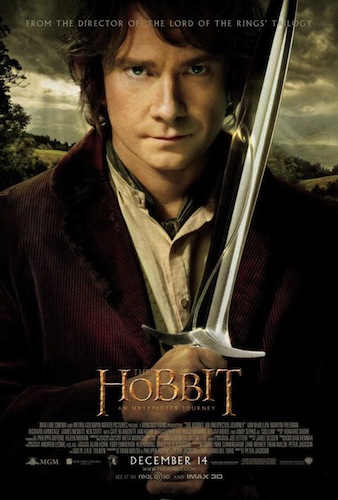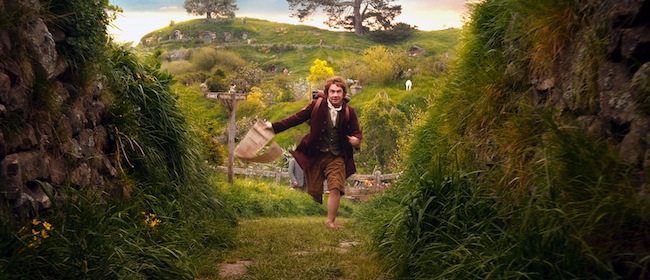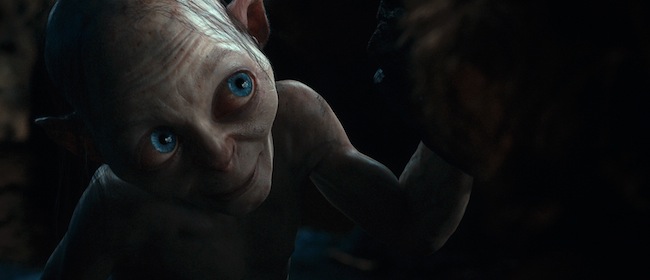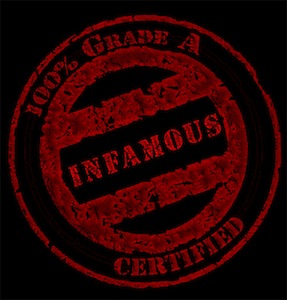
It has been nine years since our last journey through Middle-earth with Peter Jackson at the helm, and, while you could fill all that time watching the LORD OF THE RINGS Trilogy via extended editions, it’s time to set off on another quest across this world filled with elves and dwarves in the director’s first of a three-leg adaptation of J.R. Tolkien’s THE HOBBIT. This time it’s Bilbo Baggins (Martin Freeman; the elder version is played by Ian Holm), uncle of the more familiar Frodo, who we’ll be accompanying on an adventure to reclaim the land and treasure of dwarves, overtaken by a dragon many years ago. Bilbo is the unwilling 14th participant of this dwarf party, which is fronted by their leader Thorin Oakenshield (Richard Armitage) and put together by the grey wizard Gandalf (Sir Ian McKellen). As for the other 12 dwarves, Jackson never really gives us a chance to get to know them on any level, as they serve extensively as background pieces to help drive the journey from one location to the next. Not to nitpick at any deviations from the novel, but Tolkien at least gave us a sense of some of their personalities, making them included in what was happening whereas Jackson only really seems to have them on-screen because he has to, and those feelings seem to permeate throughout THE HOBBIT, which carries far less joy and whimsy than any of the LORD OF THE RINGS films, which, by their nature, were far more serious in tone. For great spans of time, Jackson’s story seems to be fueled by obligation and not passion, and, as a result, it’s a cold, emotionless film that we get on this first offering until about ¾ of the way through, when suddenly it’s as if the light finally came on as to how THE HOBBIT should play.
THE HOBBIT is ripe with pacing problems that make the film feel a ton longer than its 2 hour and 46 minute running time, which is a departure from the novel, which is quickly paced, moving you along rather nicely with the goal of getting to the Lonely Mountain in about 270 pages. I can understand where Jackson might want to expand upon some of the book’s elements that seem rushed at times with limited pages devoted to encounters with trolls and goblins. This is the forum for Jackson to create much bigger, action-packed sequences where they feel absolutely necessary. But you have to take the good with the bad, I guess, because, in addition to those set-ups (which are exciting and visually fantastic, by the way), we get these other incredibly bloated scenes that Jackson pulls from Tolkien’s other works in order to fill out THE HOBBIT into a bigger story and one that ties in a bit more closer to the previous trilogy. However, there is absolutely no connection at all to Gandalf holding council with Elrond, Galadriel and Saruman (the returning Hugo Weaving, Cate Blanchett and Christopher Lee) about the existence of the Necromancer or scenes with Radagast the Brown (Sylvester McCoy). This side-story pulls passing mentions in Tolkien’s text, but Jackson decides to expand upon them to greater degree with the moving image, and it does nothing but create a slog for THE HOBBIT. It’s not as if the film was moving along at a bang-bang pace as it was; after all, it takes 45 minutes for the film to finally exit the Hobbit-hole and get on with this adventure that will test Bilbo’s mettle. However, this isn’t the movie for it.

THE HOBBIT has always been about the examination of Bilbo Baggins – who he is, what he’s worth, what he’s capable of – and Jackson loses sight of that to great degree in AN UNEXPECTED JOURNEY by focusing on Gandalf’s side-quests and Thorin’s bitching, undercutting the self-doubt of Bilbo that really makes up so much of this story. This isn’t about Thorin questioning whether an unqualified Hobbit should be along for their dangerous ride; it really should be about Bilbo Baggins questioning himself and rising up to face the challenges he’ll encounter on this long, treacherous road. Jackson really misfires in laying the foundation for Bilbo Baggins. Martin Freeman does his best to try to create something emotional meaningful for the character, but it’s just not there in this first film, which is why THE HOBBIT feels empty for much too long. This isn’t really about Middle-earth, nor should it be, until the story builds to something a little bit bigger in scope. It’s about one Hobbit, and that’s too often forgotten here.
THE HOBBIT never really kicks into full gear until the appearance of Gollum, and suddenly the film springs to life with the famous battle of riddles between Andy Serkis’ incredible motion-capture character, who looks better than ever, and Bilbo deep in the goblin caves. You can never say that Serkis is going through the motions, as he breathes more life into Gollum than some of the other cast put into their human characters. Whether it’s a roll of the eyes or a clever smirk, these little idiosyncrasies make for a unique personality that is fun as hell to watch. There is nothing dour about watching this character in action, which I can’t quite say for just about the entire troupe of dwarves, who lose their sense of fancy once their opening dinner ends. If there were a role I wish was expanded more in THE HOBBIT, it’d be that of Gollum. I’d gladly sacrifice all the extraneous material from everyone else combined to get more of Serkis’ work.
And, as that scene continues to escalate, finally the rest of the film does, too, receiving a much-needed boot to inject this chapter of the story with some thrills. The dwarves’ fight to escape from goblins’ custody invokes fond memories of Jackson’s massive battle sequences in the LOTR Trilogy. It’s not quite the same scale, but Jackson has an eye for making these sequences not only look cool but also feel exhilarating. It’s just a shame that it took nearly two hours for THE HOBBIT to get fun, and it certainly leads to suspicions that the source material is really being stretched to make up three total films, which can only lead to more pacing problems in the future.

Finally, let me get to the giant elephant in the room – the 48 fps frame rate – for those who are curious how it plays on the big screen. THE HOBBIT is by no means the definitive statement on whether the shift in frame rate can work in the long run, but it is one fascinating experiment that showcases its benefits while frustrates with its negatives.
First off, THE HOBBIT looks absolutely amazing. You already know what it’s like to see a high-resolution image via your Blu-ray player… now imagine seeing that same image quality projected on the silver screen. It’s that crisp and that clear, enabling you to see individual feathers on an eagle’s wings or the disgusting details of a troll’s face or the spray of Rivendall’s waterfalls. This is something you haven’t seen before projected in such a way, so it sure will take you a bit to get adjusted to what you’re seeing. By the time I walked out of the theatre, I felt as if my eyes had gone through a serious boot camp workout, being used in ways they had never been before. They did feel a bit strained for the extra work they were being called upon to do. But it wasn’t just the extra detail they were being called upon to pick up. That was only the bright side of this equation. The downside is that that they were also required to move a lot faster to grasp and decipher a lot of the motion and camera movements that Jackson was using throughout the film. Close-ups and medium shots appear to move quickly at rapid speed, which is absolutely jarring when you first see it and then every time after, as if you are watching them move in fast-forward. Simple tasks like the elder Bilbo putting something away in a chest look almost comical, because of how quickly they transpire in relation to things shot from a wider angle. Pans and swishes come across like something you might see in a video game cut scene, and with the added camera movement trying to put you in the action of say a battle, it almost feels as if you’re in the middle of a 3-D motion simulator ride. I think that the new frame rate can be a worthy tool for filmmakers to use periodically, but I don’t see it becoming any sort of new standard until they learn its limitations, which means changing dramatically the way certain things are captured by the camera in order to not disorient the audience when it’s finally projected.
I am hoping that THE DESOLATION OF SMAUG and THERE AND BACK AGAIN may pick up the pace of the story a bit now that the ground-laying exposition is out of the way and the foundation is set. With any luck, Jackson will take the momentum of AN UNEXPECTED JOURNEY’s last hour and carry it through to the next two films, because this one was a tough watch, and that’s not the 48 fps’ fault. This is a slow film that absolutely feels like one part of a larger story, and not necessarily a stand-alone picture, and the only reason you wind up tolerating it is because you know there is good stuff on the road ahead. THE HOBBIT: AN UNEXPECTED JOURNEY has its moments, but, by and large, introduces disappointment to Middle-earth.
-Billy Donnelly
"The Infamous Billy The Kidd"
Follow me on Twitter.

